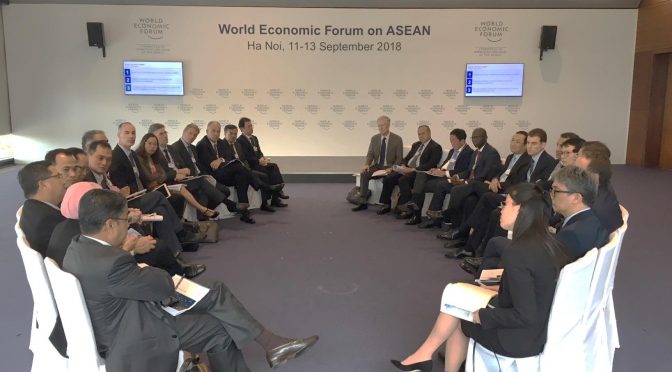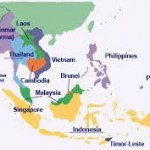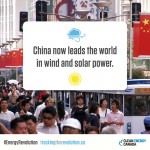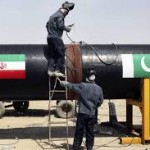
ASEAN Must Act Now to Address its Energy Transition Challenges
At the recent World Economic Forum on ASEAN, I moderated a session on ASEAN’s energy transition.
ASEAN is undergoing a phase of sustained economic growth and human development. Urbanisation and industrialisation will lead to greater per capita material consumption of all types including energy. As a consequence, ASEAN member states need to act decisively now to address several simultaneous challenges relating to energy security, investment, energy access, and environmental.
The challenges
Security of energy supply is a top priority for all member state governments. The International Energy in its 2017 in its Southeast Asia Energy Outlook 2017 projected that primary energy demand would grow by about 70% between 2016 and 2040, assuming that all new policies were fully implemented. 80% of this energy supply may be from fossil fuels.
This continuing dependence on fossil fuels raises energy security concerns for the region. After many years of being a net exporter of fossil fuels, ASEAN has steadily become a net importer of fossil fuels, and this import dependence will place an increasing fiscal burden on member states. However, ASEAN has considerable untapped resources of renewable energy including hydroelectricity, wind and solar energy, wave and tidal energy, and biofuels and biomass. So, the ASEAN Energy Outlook of 2017 projected that they should be able to provide a progressively larger share of primary energy supply.
Modernisation and industrialisation necessarily result in greater electrification. Therefore electricity demand between now and 2040 will rise by 250%, much faster than primary energy demand. This in turn will require the construction of new power generation capacity, a significant share of which should be renewable.
The International Energy Agency estimated that around 2,500 billion US dollars (2016) of investment would be needed to supply ASEAN’s projected energy needs between now and 2040. About half of this is for the power sector, and the balance would be shared between fuel supply and energy efficiency. Regardless of the accuracy of this estimate, it is clear that the amount of money needed is very large and beyond the capacity of ASEAN member states themselves.
Foreign direct investment (FDI) is therefore absolutely necessary. However, the amount of FDI into ASEAN’s energy sector has been relatively low recently for a number of reasons: the paucity of attractive projects; the low level of domestic prices for gas and electricity; and the diverse range of regulatory obstacles. Exceptions this pattern include the ongoing construction of hydroelectric dams and power transmission lines in the Mekong River Basin and Chinese investment in thermal power in Indonesia.
Human development require not just more energy to the nation but its availability and affordability to the entire population. Electricity is not just a luxury, but a vital input to improved livelihoods including standards of living, health and education. However, 50 million or more people across ASEAN lack access to electricity and an equivalent number receive a very unreliable supply. As many as 200 million rely on traditional biomass for cooking, a practice that is harmful to health and a waste of labour in the gathering of the fuel.
The final challenge relates to the environment. ASEAN member states have to find ways to supply the required energy in a sustainable manner, minimising pollution of all types: air pollution, greenhouse gases, freshwater and ground water, and land. Within ASEAN, the risks posed by coal combustion and the development of biofuels are particularly prominent. Fortunately, the costs of different forms of low carbon electricity have recently become much cheaper and large-scale electricity storage technology will be available soon.
Developing a shared vision
ASEAN member states are hugely diverse region in many respects: physical geography, size and population; the scale and nature of energy resource endowment; the size and structure of the economy and the per capita GDP; and political and economic systems. Of direct relevance to the energy sector is the variability of governance arrangements for industry and the energy sector, especially the role of the private sector and market mechanisms. Likewise, the availability of relevant skills and of investment capital is very uneven.
The combination of these factors result in policy priorities not only varying between member states but actively constraining potential energy cooperation. A preference for self-reliance in energy supply may shape the choice of fuel mix and result in a reluctance to trade energy. The preferential treatment of domestic, often state-owned energy companies coupled with an unattractive regulatory and fiscal regime act to limit foreign direct investment. Subsidies on energy products further constrain investment from all sources as well as draining the government purse.
The key to developing a shared vision for the ASEAN energy transition is to view the diversity among member states in a more positive light and identify the advantages it creates. A good starting point is the diverse endowment of primary energy resources. ASEAN possesses substantial reserves of natural gas, mainly in Indonesia, Malaysia and Myanmar, that can slowly substitute for coal in power generation. Additional supplies are available from nearby Australia.
Continental ASEAN hosts vast hydroelectric resources, but continued development needs great care to be taken with respect to environmental, social and safety risks. The region also has significant potential for renewable energy including wind, solar, marine and biomass, and supply chains for these technologies are slowly being developed. However, these need to be scaled-up. Skills and capital are also available both within and outside the Southeast Asia, but the key is to mobilise them.
The overarching task that will allow these complementarities to be realised is to fully include the energy sector within the framework of the ASEAN Economic Community. The development of a market mechanism to allow multilateral trading of electricity would provide a wide range of economic and environmental benefits.
Finally, ASEAN is at a critical decision point. A number of member state governments continue to promote coal-fired power generation over cleaner fuels, despite the falling costs of the latter and the greater availability of international finance for renewable energy. The longer this continues, the more these countries will be locked in to a fossil fuel future.






